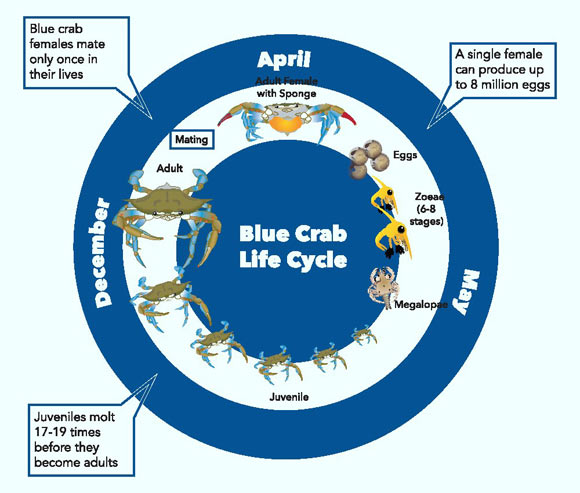A team of scientists at the University of Maryland Center for Environmental Science has successfully sequenced the genome of the blue crab (Callinectes sapidus), an economically, culturally, and ecologically important species found across the temperate and tropical North and South American Atlantic coast.

A female blue crab (Callinectes sapidus) in the permanent collection of the Children’s Museum of Indianapolis. Image credit: Wendy Kaveney / CC BY-SA 3.0.
The blue crab is a well-studied crustacean species distributed across the Western Atlantic region.
The population ranges along the western Atlantic coast from Argentina to Cape Cod in Massachusetts, United States.
In some areas, including the Chesapeake Bay, the blue crab is an important fishery species and 97,896 tons were harvested globally in 2016.
In many coastal habitats, the species also plays a key ecological role as a keystone predator on numerous smaller invertebrates and serves as prey for sea birds, turtles, and large fish species.
Additionally, the blue crab has expanded its territory as a successful invasive species to a number of coastal regions in the world, including in the Mediterranean Sea where it poses a serious problem due to its foraging ability and lack of natural predators.
“What makes crabs successful is located in the chromosomes,” said senior author Professor Sook Chung, a researcher in the Institute of Marine and Environmental Technology at the University of Maryland Center for Environmental Science.
“Knowing the full genome, we are several steps closer to identifying the genes responsible for growth, reproduction, and susceptibility to disease.”

The life cycle of the blue crab (Callinectes sapidus) involves four major life stages: in a hatchery setting, the larvae hatched in April mature to adult stage in December, which then spawn in 3 months and complete their life cycle in a calendar year; the female mates after puberty-terminal molt and travels to higher salinity waters to spawn in the mouth of Chesapeake Bay. Image credit: Bachvaroff et al., doi: 10.1093/g3journal/jkab212.
Professor Chung and colleagues found that the blue crab has between 40 and 50 chromosomes, which is nearly double the amount found in humans.
However, these chromosomes are very short, resulting in a genome that is approximately one third the length of the human genome, in terms of bases.
Despite its relatively diminutive size, the blue crab genome is rich in gene diversity, containing 25,249 genes, slightly more than the amount identified in humans.
Understanding how likely crabs are to reproduce successfully could aid in fisheries policies in places like Maryland’s Chesapeake Bay, helping to maintain a healthy ecosystem and economy.
Breeding particularly fertile females could help enable the production of blue crabs in aquaculture.
The species’ genome could also potentially be used for food source tracking to determine if the lump crab meat in the market came from Venezuela or Maryland’s coastal bays.
“Sequencing an entire genome in just four years with four scientists was a major scientific feat,” said Dr. Russell Hill, executive director of the Institute of Marine and Environmental Technology at the University of Maryland Center for Environmental Science.
“The genome will be made publicly available so that scientists anywhere can use it, and it will fuel decades of research on the blue crab and other crustaceans.”
The results were published in the journal G3: Genes, Genomes, Genetics.
_____
Tsvetan R. Bachvaroff et al. 2021. Chromosome-level genome assembly of the blue crab, Callinectes sapidus. G3: Genes, Genomes, Genetics 11 (9): jkab212; doi: 10.1093/g3journal/jkab212







